

Beluga
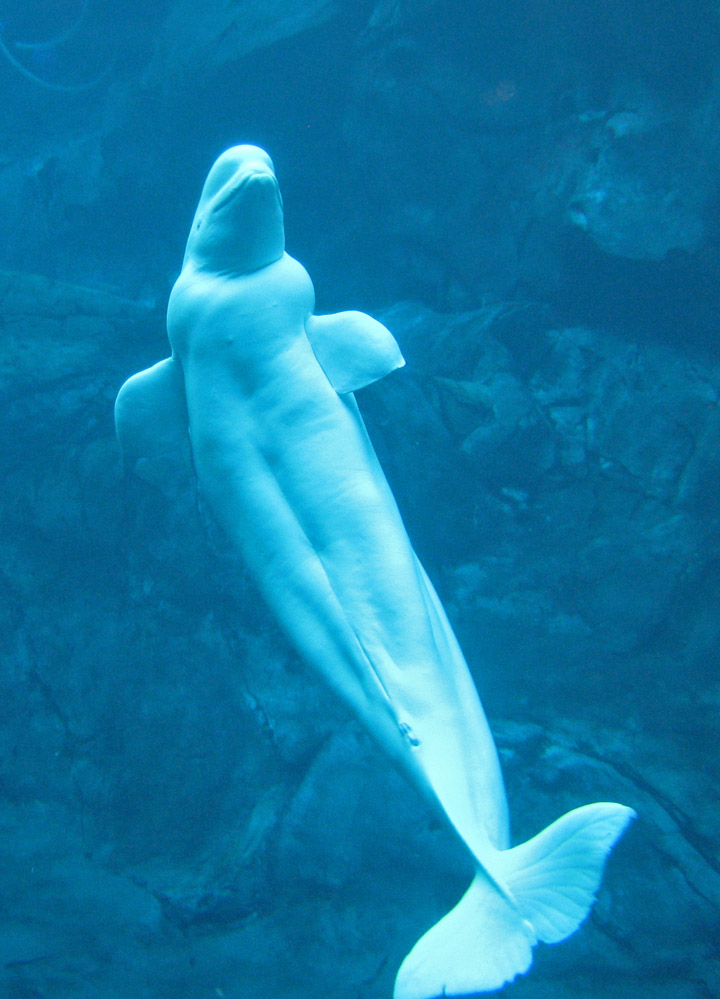
Beluga
The Beluga or White Whale (Delphinapterus leucas) is an Arctic and sub-Arctic species of cetacean. It is one of two members of the family Monodontidae, along with the Narwhal. This marine mammal is commonly referred to simply as the Beluga or Sea Canary due to its high-pitched twitter. It is up to 5 m (15 ft) in length and an unmistakable all white in color with a distinctive pretuberance on the head. Belugas from the Cook Inlet in Alaska have been placed under the protection of the Endangered Species Act by the U.S. federal government.

The Beluga was first described by Peter Simon Pallas in 1776. It is a member of
the Monodontidae family, which is in turn part of the toothed whale suborder.
The Irrawaddy Dolphin was also once considered to be in the same family;
however, recent genetic evidence suggests otherwise. The only other species
within the Monodontidae family besides the Beluga is the Narwhal.

The earliest known ancestor of the Beluga is the prehistoric Denebola
brachycephala from the late Miocene period. One single fossil has been found on
the Baja California peninsula, indicating that the family once existed in warmer
waters. The fossil record also indicates that in comparatively recent times the
Beluga's range has varied with that of the ice pack – expanded during ice ages
and contracting when the ice retreats.
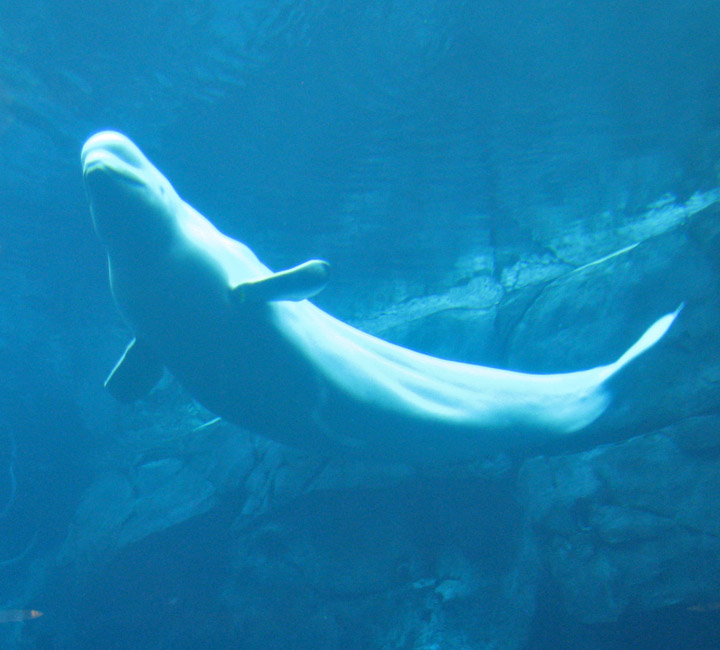
The Red List of Threatened Species gives both Beluga and White Whale as common
names, though the former is now more popular. The English name comes from the
Russian белуга (beluga) or белуха (belukha) which derives from the word белый (belyy),
meaning "white". It is sometimes referred to by scientists as the Belukha Whale
in order to avoid confusion with the beluga sturgeon. The whale is also
colloquially known as the Sea Canary on account of the high-pitched squeaks,
squeals, clucks and whistles.
A Japanese researcher says he has taught a Beluga to "talk" by using these
sounds to identify three different objects, offering hope that humans may one
day be able to hold conversations with sea mammals.
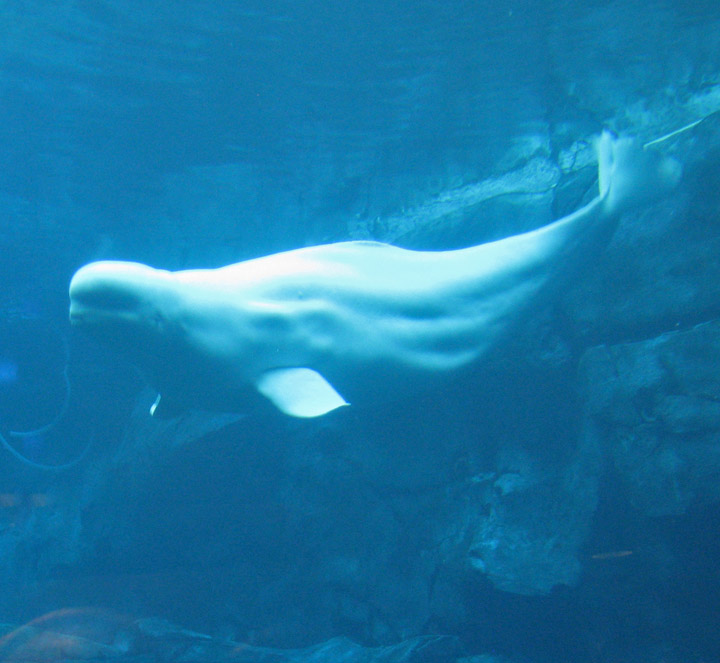
Male Belugas are larger than females. Males can reach 5.5 metres (18 ft) long,
while females grow to as much as 4.1 metres (13 ft). Males weigh between
1,100 and 1,600 kilograms (2,400 and 3,500 lb) while females weigh between 700
and 1,200 kilograms (1,500 and 2,600 lb). This is larger than all but the
largest dolphins but smaller than most other toothed whales.
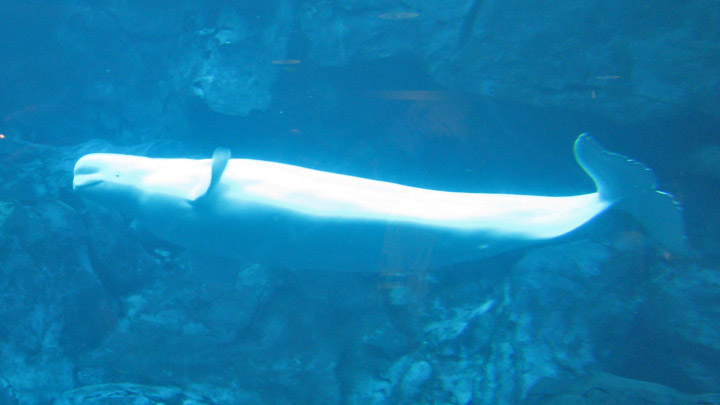
This whale is unmistakable when adult: it is all white or whitish grey. Calves,
however, are usually gray. The head is unlike that of any other cetacean. Like
most toothed whales it has a melon, an oily, fatty lump of tissue found at the
center of the forehead. But the Beluga's melon is extremely bulbous and even
malleable. The Beluga is able to change the shape of its head by blowing air
around its sinuses. Again unlike many dolphins and whales, the vertebrae in the
neck are not fused together, allowing the animal flexibility to turn its head
laterally. The rostrum has about 8 to 10 teeth on each side of the jaw.

It has a dorsal ridge rather than a dorsal fin. The absence of the dorsal fin is
reflected in the genus name of the species - apterus is the Greek word for
"wingless". The evolutionary preference for a dorsal ridge rather than a fin is
believed by scientists to be adaptation to under-ice conditions, or possibly as
a way of preserving heat. Like in other cetaceans the thyroid gland is
relatively large compared to terrestrial mammals (three times per weight as a
horse) and may help to sustain higher metabolism during the summer estuarine
occupations.
The body of the Beluga is round, particularly when well-fed, and tapers smoothly
to both the head and tail. The tail fin grows and becomes increasingly ornately
curved as the animal ages. The flippers are broad and short - making them almost
square-shaped.

The Beluga inhabits a discontinuous circumpolar distribution in Arctic and
sub-Arctic waters ranging from 50° N to 80° N, particularly along the coasts of
Alaska, Canada, Greenland and Russia. The southernmost extent of the range
includes isolated populations in the St. Lawrence River estuary and the Saguenay
fjord, around the village of Tadoussac, Quebec, in the Atlantic and the Amur
River delta, the Shantar Islands and the waters surrounding Sakhalin Island in
the Sea of Okhotsk.
In the spring the Beluga moves to its summer grounds, bays, estuaries and other
shallow inlets. These summer sites are detached from one another and a mother
will usually return to the same site year after year. As its summer homes become
clogged with ice during autumn, the Beluga moves away for winter. Most travel in
the direction of the advancing ice-pack and stay close to the edge of it for the
winter months. Others stay under the iced area - surviving by finding ice leads
and polynyas (patches of open water in the ice) in which they can surface to
breathe. Beluga may also find pockets of air trapped under the ice. The
remarkable ability of the beluga to find the thin slivers of open water where
the dense ice pack may cover more than 96% of the sea surface is still a source
of mystery and great interest to scientists. It is clear that the echo-location
capabilities of the Beluga are highly adapted to the peculiar acoustics of the
sub-ice sea and it has been suggested that beluga can sense open water through
echo-location.
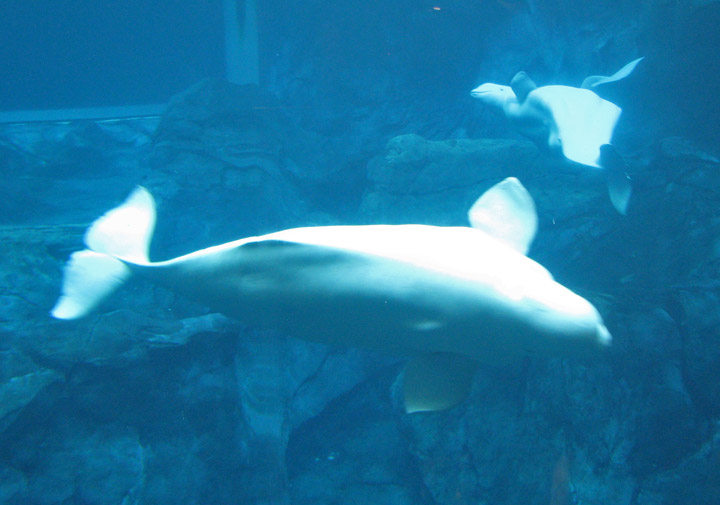
On June 9, 2006, the carcass of a young Beluga was found in the Tanana River
near Fairbanks in central Alaska, nearly 1,700 kilometres (1,100 miles) from its
nearest natural ocean habitat. As Beluga sometimes follow migrating fish, Alaska
state biologist Tom Seaton speculated that it had followed migrating salmon up
the river at some point in the prior fall.
The Beluga is a highly sociable creature. Groups of males may number in the
hundreds, but mothers with calves generally mix in slightly smaller groups. When
pods do aggregate in estuaries, they may number in the thousands. This can
represent a significant proportion of the entire beluga population and is the
time when they are most vulnerable to hunting.
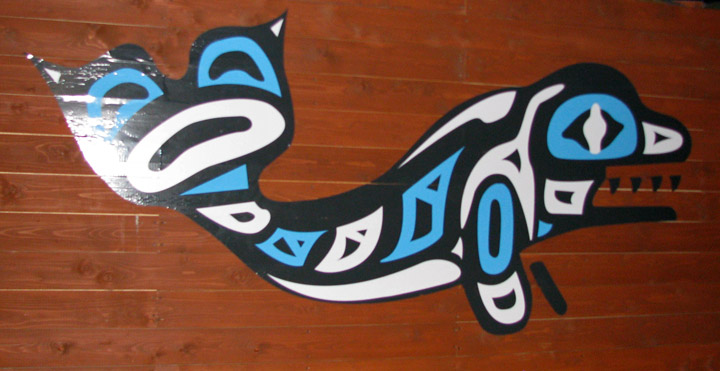
as honored by the Northwest Native Americans
Beluga pods tend to be unstable, meaning that Belugas tend to move from pod to
pod. Pod membership is rarely permanent. Radio-tracking has shown Belugas can
start out in a pod and within a few days be hundreds of miles away from that
pod. The closest social relationship between Belugas is the mother-calf
relationship. Nursing times of 2 years have been observed and lactational
anestrus may not occur. Calves often return to the same estuary as their mother
in the summer, meeting with their mother sometimes even after becoming fully
mature.
Beluga are also known for being rather playful, as well as spitting at humans or
other whales. It is not unusual for an aquarium handler to be sprayed down by
one of his charges whilst tending a Beluga tank. Some researchers believe that
this skill may be utilized to blow away sand from crustaceans at the sea bottom.
Unlike most whales, it is capable of swimming backwards.
Text from Wikipedia